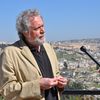I have previously argued in my books and in blogs that the earliest account of the discovery of the empty tomb of Jesus is now embedded in John 20:1-18 in which Mary Magdalene visits the tomb alone before sunrise on Sunday morning and subsequently encounters Jesus, making her the unique "first witness" to his resurrection. See my post "Mary Magdalene as 'First Witness'" here. I had been strongly influenced by the persuasive arguments of Jane Schaberg and others in this regard. I think I was mistaken.
I am now convinced that John 20:1-10 is an earlier and entirely separate narrative from John 20:11-18. In the latter Mary Magdalene returns to the tomb and only then meets Jesus, has her exchange with him, and then declares, using the language Paul equated with that of the apostles "I have seen the Lord" (1 Corinthians 9:1-2). In the former Mary visits the tomb alone and sees and hears from no one -- whether a messenger or Jesus himself. Notice carefully this discrete and amazing narrative:
Now on the first day of the week Mary Magdalene came to the tomb early, while it was still dark, and saw that the stone had been taken away from the tomb. 2 So she ran, and went to Simon Peter and the other disciple, the one whom Jesus loved, and said to them, "They have taken the Lord out of the tomb, and we do not know where they have laid him." 3 Peter then came out with the other disciple, and they went toward the tomb. 4 They both ran, but the other disciple outran Peter and reached the tomb first; 5 and stooping to look in, he saw the linen cloths lying there, but he did not go in. 6 Then Simon Peter came, following him, and went into the tomb; he saw the linen cloths lying, 7 and the napkin, which had been on his head, not lying with the linen cloths but rolled up in a place by itself. 8 Then the other disciple, who reached the tomb first, also went in, and he saw and believed; 9 for as yet they did not know the scripture, that he must rise from the dead. 10 Then the disciples went back to their homes (John 20:1-10, RSV)
What we don't have here is every bit as instructive as what we are told. Notice, there is no earthquake or angel descending from heaven and moving the heavy stone from the tomb and declaring that Jesus has been raised as Matthew 28 has it, or no "two men in dazzling apparel" as in Luke 24. There is not even a "young man clothed in white linen" declaring "he has risen" as in Mark 16. This is truly quite shocking. Think about the implications.
First Mary comes alone to the tomb when it is still dark, not with the entourage of women after sunrise that Mark (followed by Matthew and Luke) report. She encounters no one and hears nothing. Her whole assumption is a logical one -- given that Joseph of Arimathea had taken charge of the burial and temporarily placed the corpse of Jesus in an unused tomb near the site of the crucifixion until after the Passover feast (see my post, "Eastern Morning: Sorting through the Traditions" here). And that is what she reports to Peter and the "other disciple whom Jesus loved," namely that "they [the burial party] have taken the Lord out of the tomb and we do not know where they have laid him." And that is precisely what one would expect, and I would argue, that is precisely what happened. Joseph and his entourage would have come at the end of the Sabbath Festival, after sundown Saturday evening in a hurry to carry out the permanent burial of Jesus' corpse. The two disciples race to the tomb to verify her story that it is indeed empty. They make no assumptions about him being raised from the dead. And then, most significantly,"they went back to their homes."
I would argue here that John 20:1-10 is the earliest tradition of the empty tomb and thus records the tradition, known to Mark (and followed by Matthew), embedded in the appendix we now know as John 21, and in the ending of the Gospel of Peter, that the disciples, and indeed the entire Jesus entourage, returned to Galilee after Passover without seeing Jesus (see the post "Weeping Through Easter," here.
What we apparently have surviving in John 20:1-10 is a tradition of Mary Magdalene's visit to the tomb that surely has to be the most primitive of all our accounts, even predating that of Paul in 1 Corinthians 15:1-3. Paul is concerned with "sightings" of Jesus, and though he provides no "chronology," he does refer to the "after three days" tradition and an appearance to Peter--which is clearly secondary to both Mark 16:1-18 and this account in John 20:1-10.
John 20:1-10 is a precious glimpse into a most plausible historical scenario as to what happened after Jesus' death, and why the temporary tomb into which Jesus was placed was indeed empty, before the various theological presentations involving "sightings" of Jesus began to accrue to the story. Indeed, our first literary witness, the apostle Paul, builds everything upon "visions" of Jesus in a glorious "spiritual body" and has no interest in the tomb being empty or in the corruptible "body of dust" being reanimated.
